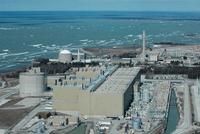-
Lawmakers urge NRC not to exempt shut-down nuclear plants from emergency, security regulations
Lawmakers are urging the U.S. Nuclear Regulatory Commission (NRC) to halt exemption of recently- shuttered nuclear power plants from emergency-planning and security regulations. The lawmakers are especially concerned about the nuclear waste which will continue to be stored on the grounds of shut-down nuclear plants, saying that the stored radioactive waste continues to be a security threat whether or not the plant itself is still operational.
-
-
Western intelligence: Assad plans to retain residual chemical weapons capability
Israeli intelligence officials say the regime of President Bashar Assad in Syria may be concealing a small amount of the chemical weapons in its possession, while pretending that it is fully cooperating with the process to remove all chemical weapons from Syria. This assessment is similar to conclusions reached by the U.S. and U.K. intelligence communities in the past two weeks. The Israeli view is that the retention of chemicals by the Assad regime has to do with the ongoing fight against the rebels, and is not an indication that the regime is contemplating their use against Israel. A senior intelligence source also said that unlike the consensus in the intelligence community a year or two ago, the Israeli defense establishment no longer considers bringing down the regime in Damascus as necessarily positive for Israel.
-
-
DHS cancels acquisition of BioWatch’s Generation 3 technology
Owing to concerns about BioWatcheffectiveness and high cost, DHS has canceled plans to install an automated technology meant to speed the 24-hour operations of the program, the nation’s system for detecting a biological attack.ASeptember 2012 GAO report estimated that annual costs to operate the Generation 3 technology would be “about four times more” than the existing BioWatch system.
-
-
New scanning technique may end on-board liquid restrictions
A new machine which can identify the chemical composition of liquids sealed within non-metallic containers without opening them is one of three candidates announced Monday to be in the running to win the U.K.’s premier engineering prize, the MacRobert Award. Already being deployed in sixty-five airports across Europe, this innovation can protect travelers by screening for liquid explosives and could spell the end of the ban on liquids in hand luggage.
-
-
Birds in and around Chernobyl's exclusion zone adapting to ionizing radiation

Birds in the exclusion zone around Chernobyl are adapting to — and may even be benefiting from — long-term exposure to radiation, ecologists have found. The study is first evidence that wild animals adapt to ionizing radiation, and the first to show that birds which produce most pheomelanin, a pigment in feathers, have greatest problems coping with radiation exposure.
-
-
Threats from insiders are the most serious security challenges nuclear facilities face

Insider threats are the most serious challenge confronting nuclear facilities in today’s world, a new study says. In every case of theft of nuclear materials where the circumstances of the theft are known, the perpetrators were either insiders or had help from insiders, the study found. Theft is not the only danger facing facility operators; sabotage is a risk as well, the study authors say.
-
-
PathSensors introduces portable pathogen identifier system

Baltimore, Maryland-based PathSensors, Inc. has introduced the portable Zephyr Pathogen Identifier system. The company says it delivers rapid, reliable detection of bacteria, virus, and toxins in powder and liquid samples in minutes. The Zephyr Identifier uses CANARY (Cellular Analysis and Notification of Antigen Risks and Yields) technology, which is licensed from the MIT-Lincoln Laboratory.
-
-
One in ten American schoolchildren in school near risky chemical facility
One year after the fertilizer facility explosion in West, Texas, which destroyed and severely damaged nearby schools, nearly one in ten American schoolchildren live and study within one mile of a potentially dangerous chemical facility. A new study shows that 4.6 million children at nearly 10,000 schools across the country are within a mile of a facility which produces, uses, or stores significant quantities of hazardous chemicals identified by EPA as particularly risky to human health or the environment if they are spilled, released into the air, or are involved in an explosion or fire.
-
-
S.C. fights to keep costly plutonium processing project alive
The United States and Russia have agreed to dispose of thirty-four tons of weapon-grade plutonium each, an amount equal to 17,000 nuclear warheads. The United States budgeted $4 billion for a mixed-oxide fuel project, known as MOX, at the Savannah River Site, S.C., to process the plutonium, but construction costs have now reached $8 billion, and officials estimate the facility will cost about $30 billion over its operating years. DOE has suspended the MOX project and is looking for alternative plutonium processing methods. South Carolina has sued the federal government, arguing that since Congress has authorized the funds for MOX, the administration must spend the money.
-
-
Some see small modular reactors as offering a better future for the nuclear industry
A full-size reactor costs up to $8 billion, takes years to build, and decades to achieve a return on investment. Some experts say the future of the nuclear industry should be based on small underground reactors, which are cheaper and quicker to build. Other experts say that smaller reactors mean needing many more of them to produce the same amount of power as traditional reactors, and having more reactors means increasing security concerns.
-
-
Detecting and defeating radiological threats
Brookhaven National Laboratory’s Radiological Assistance Program (RAP) team works to stay ahead of any radiological threats by using many detection tools that have become increasingly sophisticated and user-friendly. During a deployment, researchers and technicians with backgrounds in various aspects of radiological controls and analysis conduct field monitoring and environmental sampling, assessment, and documentation activities to help decision makers choose appropriate protective actions for the safety of both the public and first responders.
-
-
Debate over Ontario, Canada underground nuclear waste facility intensifies

Ontario Power Generation’s (OPG) proposal to construct an underground nuclear waste disposal facility near the company’s Bruce Nuclear plantand on the edge of the Great Lakes is facing growing opposition from local municipalities and environmentalists. The facility would store low and intermediate nuclear waste from OPG’s Bruce, Pickering, and Darlington nuclear facilities. Environmentalists are concerned that a leak in the underground facility would be devastating for communities which depend on water from the Great Lakes.
-
-
NC State awarded $25 million NNSA grant to launch nuclear proliferation detection effort
North Carolina State University was awarded a 5-year, $25 million grant by the National Nuclear Security Administration’s (NNSA) to develop the next generation of leaders with practical experience in technical fields relevant to nuclear nonproliferation. The new Consortium for Nonproliferation Enabling Capabilities, or CNEC, aims to be the pre-eminent research and education hub dedicated to the development of enabling technologies and technical talent for meeting the challenges of nuclear nonproliferation in the next decade.
-
-
Amid controversy, Boston City council debates banning Level 4 Biolab
Boston has long been seen as “America’s Medical Capital,” but that may soon change if the city passes a measure to ban Level 4 Biolab disease research at Boston University’s National Emerging Infectious Diseases Laboratory – research which includes deadly and untreatable strains that could decimate an exposed urban population in the event of an accident or terrorist activity.
-
-
New detection technology to help combat nuclear trafficking
According to the International Atomic Energy Agency (IAEA), the greatest danger to nuclear security comes from terrorists acquiring sufficient quantities of plutonium or highly enriched uranium (HEU) to construct a crude nuclear explosive device. The IAEA also notes that most cases of illicit nuclear trafficking have involved gram-level quantities, which can be challenging to detect with most inspection methods. Special algorithm coupled with commercial X-ray scanners allows detection of small amounts of fissile materials in luggage.
-
More headlines
The long view
Keeping the Lights on with Nuclear Waste: Radiochemistry Transforms Nuclear Waste into Strategic Materials
How UNLV radiochemistry is pioneering the future of energy in the Southwest by salvaging strategic materials from nuclear dumps –and making it safe.
Model Predicts Long-Term Effects of Nuclear Waste on Underground Disposal Systems
The simulations matched results from an underground lab experiment in Switzerland, suggesting modeling could be used to validate the safety of nuclear disposal sites.
